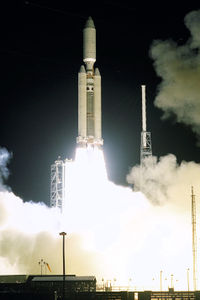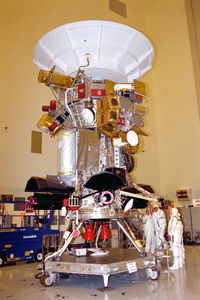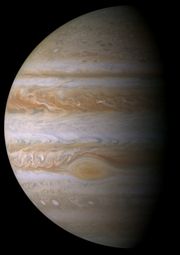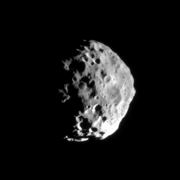Cassini-Huygens
2007 Schools Wikipedia Selection. Related subjects: Space transport
| Cassini-Huygens | |
|---|---|
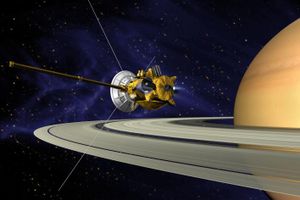 An artist's concept of Cassini |
|
| Organization: | NASA/ESA/ ASI |
| Mission type: | Fly-by, orbiter, and lander |
| Flyby of: | Jupiter, Phoebe, Titan, Enceladus |
| Satellite of: | Saturn |
| Launch Date: | October 15, 1997 |
| Launch Vehicle: | Titan IV-B/Centaur launch vehicle |
| NSSDC ID: | 1997-061A |
| Webpage: | Cassini-Huygens Home |
Cassini-Huygens is a joint NASA/ESA/ ASI unmanned space mission intended to study Saturn and its moons. The spacecraft consists of two main elements: the NASA Cassini orbiter, named after the Italian-French astronomer Giovanni Domenico Cassini, and the ESA Huygens probe, named after the Dutch astronomer Christiaan Huygens. It was launched on October 15, 1997 and entered into orbit around Saturn on July 1, 2004. On December 25, 2004 the Huygens probe separated from the orbiter at approximately 02:00 UTC, with deployment confirmed by the Jet Propulsion Laboratory. The probe reached Saturn's moon Titan on January 14, 2005, where it made an atmospheric descent to the surface and relayed scientific information. It is the first spacecraft to orbit Saturn and the fourth spacecraft to visit Saturn.
Overview
Cassini's principal objectives are to:
- Determine the three-dimensional structure and dynamic behaviour of the rings
- Determine the composition of the satellite surfaces and the geological history of each object
- Determine the nature and origin of the dark material on Iapetus's leading hemisphere
- Measure the three-dimensional structure and dynamic behaviour of the magnetosphere
- Study the dynamic behaviour of Saturn's atmosphere at cloud level
- Study the time variability of Titan's clouds and hazes
- Characterize Titan's surface on a regional scale
The Cassini-Huygens spacecraft was launched on October 15, 1997 from Cape Canaveral Air Force Station's Launch Complex 40 using a U.S. Air Force Titan IVB/ Centaur launch vehicle. The launch vehicle was made up of a two-stage Titan IV booster rocket, two strap-on solid rocket motors, the Centaur upper stage, and a payload enclosure, or fairing. The complete Cassini flight system was composed of the launch vehicle and the spacecraft.
The spacecraft is composed of the Cassini orbiter and the Huygens probe. The Cassini orbiter is planned to orbit Saturn and its moons for four years, and the plan sees the Huygens probe dive into the atmosphere of Titan and land on its surface. Cassini-Huygens is an international collaboration between three space agencies. Seventeen nations contributed to building the spacecraft. The Cassini orbiter was built and managed by NASA/ CalTech's Jet Propulsion Laboratory. The Huygens probe was built by the European Space Agency. The Italian Space Agency provided Cassini's high-gain communication antenna, and a revolutionary compact and light-weight multimode radar (synthetic aperture radar, radar altimeter, radiometer).
The total cost of the Cassini-Huygens mission is about US$3.26 billion, including $1.4 billion for pre-launch development, $704 million for mission operations, $54 million for tracking and $422 million for the launch vehicle. The U.S. contributed $2.6 billion, the European Space Agency $500 million and the Italian Space Agency $160 million.
Normally spoken, Cassini mission would end in 2008, but it is quite certain that further funding will be granted.
- A list of Cassini-Huygens abbreviations is available.
History
Cassini-Huygens' origins date to 1982, when the European Science Foundation and the American National Academy of Sciences formed a working group to investigate future cooperative missions. Two European scientists suggested a paired Saturn Orbiter and Titan Probe as a possible joint mission. In 1983, NASA's Solar System Exploration Committee recommended the same Orbiter and Probe pair as a core NASA project. NASA and the European Space Agency (ESA) performed a joint study of the potential mission from 1984 to 1985. ESA continued with its own study in 1986, while American astronaut Sally Ride, in her influential 1987 report " NASA Leadership and America's Future in Space," also examined and approved of the Cassini mission.
While Ride's report described the Saturn orbiter and probe as a NASA solo mission, in 1988 the Associate Administrator for Space Science and Applications of NASA Len Fisk returned to the idea of a joint NASA and ESA mission. He wrote to his counterpart at the ESA, Roger Bonnet, strongly suggesting that the ESA choose the Cassini mission from the three candidates at hand and promising that NASA would commit to the mission as soon as ESA did.
At the time, NASA was becoming more sensitive to the strain that had developed between the American and European space programs as a result of European perceptions that NASA had not treated it like an equal during previous collaborations. NASA officials and advisors involved in promoting and planning Cassini-Huygens attempted to correct this trend by stressing their desire to evenly share any scientific and technology benefits resulting from the mission. In part, this newfound spirit of cooperation with Europe was driven by a sense of competition with the Soviet Union, which had begun to cooperate more closely with Europe as the ESA drew further away from NASA.
The collaboration not only improved relations between the two space programs but also helped Cassini-Huygens survive congressional budget cuts in the US. Cassini-Huygens came under fire in both 1992 and 1994, but NASA successfully persuaded the U.S. Congress that it would be unwise to halt the project after the ESA had already poured funds into development because frustration on broken space exploration promises might spill over into other areas of foreign relations. The project proceeded politically smoothly after 1994, although, as noted below, citizens groups concerned about its potential environmental impact attempted to derail it through protests and lawsuits until and past its 1997 launch.
Spacecraft design
The spacecraft was originally planned to be the second three-axis stabilized, RTG-powered Mariner Mark II, a class of spacecraft developed for missions beyond the orbit of Mars. Cassini was being developed together with the Comet Rendezvous Asteroid Flyby (CRAF) spacecraft, but various budget cuts and rescopings of the project forced NASA to terminate CRAF development in order to save Cassini. As a result, the Cassini spacecraft became a more specialized design, cancelling the implementation of the Mariner Mark II series.
The Cassini spacecraft, including the orbiter and the Huygens probe, is the largest and most complex interplanetary spacecraft built to date. The orbiter alone has a mass of 2150 kilograms. When the 350-kilogram Huygens probe, launch vehicle adapter, and 3132 kilograms of propellants were loaded at launch, the spacecraft had a mass of about 5600 kilograms. Only the two Phobos spacecraft sent to Mars by the Soviet Union were heavier. The Cassini spacecraft stood more than 6.8 metres (22.3 feet) high, and was more than 4 metres (13.1 feet) wide. The complexity of the spacecraft is necessitated both by its trajectory, or flight path, to Saturn, and by the ambitious program of scientific observations to be undertaken once the spacecraft reaches its destination. It functions with 1,630 interconnected circuits, 22,000 wire connections, and over 14 kilometers (8.7 miles) of cabling.
Now that Cassini is at Saturn, it is between 8.2 and 10.2 astronomical units from Earth. Because of this, it takes between 68 to 84 minutes for signals to travel from Earth to the spacecraft, and vice versa. In practical terms, this means that ground controllers are not able to give " real-time" instructions to the spacecraft, either for day-to-day operations or in cases of unexpected in-flight events. Even if controllers respond immediately after becoming aware of a problem, nearly three hours will have passed before they receive a response from the spacecraft.
Instruments
Cassini's instrumentation consists of: a synthetic aperture RADAR mapper, a CCD imaging system, a visible/ infrared mapping spectrometer, a composite infrared spectrometer, a cosmic dust analyzer, a radio and plasma wave experiment, a plasma spectrometer, an ultraviolet imaging spectrograph, a magnetospheric imaging instrument, a magnetometer, an ion/neutral mass spectrometer. Telemetry from the communications antenna as well as other special transmitters (an S-band transmitter and a dual-frequency Ka-band system) will also be used to make observations of the atmospheres of Titan and Saturn and to measure the gravity fields of the planet and its satellites.
- Cassini Plasma Spectrometer (CAPS)
- The Cassini Plasma Spectrometer (CAPS) is a direct sensing instrument that measures the energy and electrical charge of particles such as electrons and protons that the instrument encounters. CAPS will measure the molecules originating from Saturn's ionosphere and also determine the configuration of Saturn's magnetic field. CAPS will also investigate plasma in these areas as well as the solar wind within Saturn's magnetosphere.
- Cosmic Dust Analyzer (CDA)
- The Cosmic Dust Analyzer (CDA) is a direct sensing instrument that measures the size, speed, and direction of tiny dust grains near Saturn. Some of these particles are orbiting Saturn, while others may come from other solar systems. The Cosmic Dust Analyzer onboard the Cassini orbiter is ultimately designed to help discover more about these mysterious particles, and significantly add to the knowledge of the materials in other celestial bodies and potentially more about the origins of the universe.
- Composite Infrared Spectrometer (CIRS)
- The Composite Infrared Spectrometer (CIRS) is a remote sensing instrument that measures the infrared light coming from an object (such as an atmosphere or moon surface) to learn more about its temperature and what it's made of. Throughout the Cassini-Huygens mission, CIRS will measure infrared emissions from atmospheres, rings and surfaces in the vast Saturn system to determine their composition, temperatures and thermal properties. It will map the atmosphere of Saturn in three dimensions to determine temperature and pressure profiles with altitude, gas composition, and the distribution of aerosols and clouds. This instrument will also measure thermal characteristics and the composition of satellite surfaces and rings.
- Ion and Neutral Mass Spectrometer (INMS)
- The Ion and Neutral Mass Spectrometer (INMS) is a direct sensing instrument that analyzes charged particles (like protons and heavier ions) and neutral particles (like atoms) near Titan and Saturn to learn more about their atmospheres. INMS is intended also to measure the positive ion and neutral environments of Saturn's icy satellites and rings.
- Imaging Science Subsystem (ISS)
- The Imaging Science Subsystem (ISS) is a remote sensing instrument that captures images in visible light, and some in infrared and ultraviolet light. The ISS has a camera that can take a broad, wide-angle picture and a camera that can record small areas in fine detail. Scientists anticipate that Cassini will be able to use ISS to return hundreds of thousands of images of Saturn and its rings and moons. ISS includes two cameras; a Wide Angle Camera (WAC) and a Narrow Angle Camera (NAC). Each uses a sensitive charge-coupled device (CCD) as its detector. Each CCD consists of a 1,024 square array of pixels, 12 μm on a side. The camera's system allows for many data collection modes, including on-chip data compression. Both cameras are fitted with spectral filters that rotate on a wheel—to view different bands within the electromagnetic spectrum ranging from 0.2 to 1.1 μm.
- Dual Technique Magnetometer (MAG)
- The Dual Technique Magnetometer (MAG) is a direct sensing instrument that measures the strength and direction of the magnetic field around Saturn. The magnetic fields are generated partly by the intensely hot molten core at Saturn's centre. Measuring the magnetic field is one of the ways to probe the core, even though it is far too hot and deep to actually visit. MAG's goals are to develop a three-dimensional model of Saturn's magnetosphere, as well as determine the magnetic state of Titan and its atmosphere, and the icy satellites and their role in the magnetosphere of Saturn.
- Magnetospheric Imaging Instrument (MIMI)
- The Magnetospheric Imaging Instrument (MIMI) is both a direct and remote sensing instrument that produces images and other data about the particles trapped in Saturn's huge magnetic field, or magnetosphere. This information will be used to study the overall configuration and dynamics of the magnetosphere and its interactions with the solar wind, Saturn's atmosphere, Titan, rings, and icy satellites.
- Radio Detection and Ranging Instrument (RADAR)
- The Radio Detection and Ranging Instrument (RADAR) is a remote active and remote passive sensing instrument that will produce maps of Titan's surface and measures the height of surface objects (like mountains and canyons) by bouncing radio signals off of Titan's surface and timing their return. Radio waves can penetrate the thick veil of haze surrounding Titan. In addition to bouncing radio waves, the RADAR instrument will listen for radio waves that Saturn or its moons may be producing.
- Radio and Plasma Wave Science instrument (RPWS)
- The Radio and Plasma Wave Science instrument (RPWS) is a direct and remote sensing instrument that receives and measures the radio signals coming from Saturn, including the radio waves given off by the interaction of the solar wind with Saturn and Titan. The major functions of the RPWS are to measure the electric and magnetic wave fields in the interplanetary medium and planetary magnetospheres. The instrument will also determine the electron density and temperature near Titan and in some regions of Saturn's magnetosphere. RPWS studies the configuration of Saturn's magnetic field and its relationship to Saturn Kilometric Radiation (SKR), as well as monitoring and mapping Saturn's ionosphere, plasma, and lightning from Saturn's (and possibly Titan's) atmosphere.
- Radio Science Subsystem (RSS)
- The Radio Science Subsystem (RSS) is a remote sensing instrument that uses radio antennas on Earth to observe the way radio signals from the spacecraft change as they are sent through objects, such as Titan's atmosphere or Saturn's rings, or even behind the sun. The RSS also studies the compositions, pressures and temperatures of atmospheres and ionospheres, radial structure and particle size distribution within rings, body and system masses and gravitational waves. The instrument uses the spacecraft X-band communication link as well as S-band downlink and Ka-band uplink and downlink.
- Ultraviolet Imaging Spectrograph (UVIS)
- The Ultraviolet Imaging Spectrograph (UVIS) is a remote sensing instrument that captures images of the ultraviolet light reflected off an object, such as the clouds of Saturn and/or its rings, to learn more about their structure and composition. Designed to measure ultraviolet light over wavelengths from 55.8 to 190 nm, this instrument is also a valuable tool to help determine the composition, distribution, aerosol particle content and temperatures of their atmospheres. This sensitive instrument is different from other types of spectrometers because it can take both spectral and spatial readings. It is particularly adept at determining the composition of gases. Spatial observations take a wide-by-narrow view, only one pixel tall and 60 pixels across. The spectral dimension is 1,024 pixels per spatial pixel. Additionally, it is capable of taking so many images that it can create movies to show the ways in which this material is moved around by other forces.
- Visible and Infrared Mapping Spectrometer (VIMS)
- The Visible and Infrared Mapping Spectrometer (VIMS) is a remote sensing instrument that is actually made up of two cameras in one: one is used to measure visible wavelengths, the other infrared. VIMS captures images using visible and infrared light to learn more about the composition of moon surfaces, the rings, and the atmospheres of Saturn and Titan. VIMS also observes the sunlight and starlight that passes through the rings to learn more about ring structure. VIMS is designed to measure reflected and emitted radiation from atmospheres, rings and surfaces over wavelengths from 350 to 5100 nm. It will also help determine the compositions, temperatures and structures of these objects. With VIMS, scientists also plan to perform long-term studies of cloud movement and morphology in the Saturn system, to determine the planet's weather patterns.
The Huygens probe
The Huygens probe, supplied by the European Space Agency (ESA) and named after the Dutch 17th century astronomer Christiaan Huygens, scrutinized the clouds, atmosphere, and surface of Saturn's moon Titan in its descent on 15 January 2005. It was designed to enter and brake in Titan's atmosphere and parachute a fully instrumented robotic laboratory down to the surface. The Huygens probe system consisted of the probe itself, which descended to Titan, and the probe support equipment (PSE) on Cassini, which remained attached to the orbiting spacecraft. The PSE includes the electronics necessary to track the probe, to recover the data gathered during its descent, and to process and deliver the data to the orbiter, from which it was transmitted or "downlinked" to Earth. The Probe Data Relay Subsystem (PDRS) for the radio link between Huygens and Cassini to transmit the scientific data collected during the descent on Titan, and the Command Data Management Subsystem (CDMS), that will automatically manage the entire mission of the probe that cannot be telecommanded because of the distance from Earth, were provided by the Italian Space Agency ( ASI).
Important events and discoveries
Venus and cruise to Jupiter
Cassini performed two Gravity-assisted flyby of Venus on April 26, 1998 and June 24, 1999.
On August 18, 1999 at 03:28 UTC Cassini did a gravity-assisted flyby of Earth. An hour 20 minutes before closest approach, Cassini made the closest approach to the Moon at 377,000 km, and took a series of calibration images.
On January 23, 2000 Cassini performed a flyby of Asteroid 2685 Masursky around 10:00 UTC. Cassini took images 5 to 7 hours before at 1.6 million km distance and estimated a diameter of 15 to 20 km.
Jupiter flyby
Cassini made its closest approach to Jupiter on December 30, 2000, and performed many scientific measurements. About 26,000 images were taken of Jupiter during the course of the months-long flyby. The most detailed global colour portrait of Jupiter ever was produced (see image at right), in which the smallest visible features are approximately 60 km (40 miles) across.
A major finding of the Jupiter flyby, announced on March 6, 2003, was of the nature of Jupiter's atmospheric circulation. Dark "belts" alternate with light "zones" in the atmosphere. Scientists had long considered the zones, with their pale clouds, to be areas of upwelling air, partly because many clouds on Earth form where air is rising. Analysis of Cassini imagery, however, told a new story. Individual storm cells of upwelling bright-white clouds, too small to see from Earth, pop up almost without exception in the dark belts. According to Anthony Del Genio of NASA's Goddard Institute for Space Studies, "We have a clear picture emerging that the belts must be the areas of net-rising atmospheric motion on Jupiter, with the implication that the net motion in the zones has to be sinking."
Other atmospheric observations made included a swirling dark oval of high-atmosphere haze, about the size of the Great Red Spot, near Jupiter's north pole. Infrared imagery revealed aspects of circulation near the poles, with bands of globe-encircling winds, with adjacent bands moving in opposite directions.
The same announcement also discussed the nature of Jupiter's rings. Light scattering by particles in the rings revealed the particles were irregularly shaped (as opposed to being spherical) and likely originate as ejecta from micrometeorite impacts on Jupiter's moons, probably Metis and Adrastea.
Test of Einstein's theory of general relativity
On October 10, 2003, the Cassini science team announced the results of a test of Einstein's theory of general relativity, using radio signals from the Cassini probe. The researchers observed a frequency shift in the radio waves to and from the spacecraft, as those signals traveled close to the Sun. According to the theory of general relativity, a massive object like the Sun causes space-time to curve, and a beam of radio waves (or light) that passes by the Sun has to travel further because of the curvature. The extra distance that the radio waves travel from Cassini past the Sun to the Earth delays their arrival; the amount of the delay provides a sensitive test of the predictions of Einstein's theory. Although deviations from general relativity are expected in some cosmological models, none were found in this experiment. Past tests were in agreement with the theoretical predictions with an accuracy of one part in one thousand. The Cassini experiment improved this to about 20 parts in a million, with the data still supporting Einstein's theory.
Spoke phenomenon verified
In images captured 5 September 2005, Cassini finally detected spokes in Saturn's rings, hitherto seen only by famed visual observer Stephen James O'Meara in 1977 and later confirmed by the Voyager spacecraft in the early 1980s. The exact cause of the spokes is not yet understood; some models predicted spokes would not be visible again until 2007.
New moons of Saturn
Using images taken by Cassini, two new moons of Saturn were discovered in June, 2004. They are both very small and were given the provisional names S/2004 S 1 and S/2004 S 2 before being named Methone and Pallene at the end of 2004.
On May 1, 2005, a new moon was discovered by Cassini in the Keeler gap. It was given the designation S/2005 S 1 before being named Daphnis. The only other moon inside Saturn's ring system is Pan.
Phoebe flyby
On June 11, 2004, Cassini flew by the moon Phoebe. This was the first opportunity for close-up studies of this moon since the Voyager 2 flyby. It also was Cassini's only possible flyby for Phoebe due to the mechanics of the available orbits around Saturn.
First close up images were received on June 12, 2004, and mission scientists immediately realized that the surface of Phoebe looks different from asteroids visited by spacecraft. Parts of the heavily cratered surfaces look very bright in those pictures, and it is currently believed that a large amount of water ice exists under its immediate surface.
Saturn rotation
In an announcement on June 28, 2004 Cassini scientists described the measurement of the rotational period of Saturn. Since there are no fixed features on the surface that can be used to obtain this period, the repetition of radio emissions was used. These new data agree with the latest values measured from Earth, and constitute a puzzle to the scientists. It turns out that the radio rotational period has changed since it was first measured in 1980 by Voyager, and that it is now 6 minutes longer. This doesn't indicate a change in the overall spin of the planet, but is thought to be due to movement of the source of the radio emissions to a different latitude, at which the rotation rate is different.
Orbiting Saturn
On July 1, 2004, the spacecraft flew through the gap between the F and G rings and achieved orbit, after a seven year voyage. It is the first spacecraft to ever orbit Saturn.
The Saturn Orbital Insertion (SOI) maneuver performed by Cassini was notably complex, requiring the craft to orient its High-Gain Antenna away from Earth and along its flight path, in order to shield its instruments from particles in Saturn's rings. Once the craft crossed the ring plane, it then had to rotate again so that its engine was pointed along its flight path, and then the engine fired to decelerate the craft and allow Saturn to capture it. Cassini was captured by Saturn's gravity at around 8:54 p.m. Pacific Daylight Time on June 30, 2004. During the maneuver Cassini passed within 20,000 km (13,000 miles) of Saturn's cloud tops.
Titan flybys
Cassini had its first distant flyby of Saturn's largest moon, Titan, on July 2, 2004, only a day after orbit insertion, when it approached to within 339,000 kilometers (211,000 miles) of Titan and provided the best look at the moon's surface to date. Images taken through special filters (able to see through the moon's global haze) showed south polar clouds thought to be composed of methane and surface features with widely differing brightness. On October 27, 2004 the spacecraft executed the first of the 45 planned close flybys of Titan when it flew a mere 1,200 kilometers above the moon. Almost four gigabits of data were collected and transmitted to Earth, including the first radar images of the moon's haze-enshrouded surface. Radar imagery observed no conclusive evidence of lakes of liquid hydrocarbons, though it did not dismiss the possibility such lakes could exist. It also revealed the surface of Titan (at least the area covered by radar) to be relatively level, with topography reaching no more than about 50 meters in altitude. The flyby provided a remarkable increase in imaging resolution over previous coverage. Images with up to 100 times higher resolution were taken and are typical of resolutions planned for subsequent Titan flybys.
Huygens encounter with Titan
Cassini released the Huygens probe on 25 December 2004, by means of a spring. It entered the atmosphere of Titan on January 14, 2005. For more information on the landing, see Huygens probe.
Enceladus flybys
During the first two close flybys of the moon Enceladus in 2005, Cassini discovered a "deflection" in the local magnetic field that is characteristic for the existence of a thin but significant atmosphere. Other measurements obtained at that time point to ionized water vapor as being its main constituent. Cassini also observed water ice geysers erupting from the south pole of Enceladus giving more credibility to the idea that Enceladus is supplying the particles of Saturn's E ring. Mission scientists hypothesize that there may be pockets of liquid water near the surface of the moon that fuel the eruptions, making Enceladus one of the few bodies in our solar system to have liquid water present.
Radio occultations of Saturn's rings
In May 2005, Cassini began a series of occultation experiments, designed to measure the size-distribution of particles in Saturn's rings, and to measure the atmosphere of Saturn itself. For over 4 months, Cassini will complete orbits specifically designed for this purpose. During these occultation experiments, Cassini will fly behind the ring plane of Saturn, as seen from Earth, and transmit radio waves through the particles. The radio signals are received on Earth, where the frequency, phase, and power of the signal is analyzed to help determine the structure of the rings.
Lakes of Titan
Radar images obtained on July 21, 2006 appear to show lakes of liquid hydrocarbons (such as methane and ethane) in Titan's northern latitudes. This is the first discovery of currently-existing lakes anywhere besides Earth. The lakes range in size from about a kilometer to one which is one hundred kilometers across.
Saturn hurricane
In November 2006, scientists discovered a storm at the south pole of Saturn with a distinct eyewall. This characteristic of a hurricane on Earth had never been seen on another planet before. Unlike a hurricane, the storm appears to be stationary at the pole. The storm is 5,000 miles across, 45 miles high and packing winds blowing 350 miles per hour.
Trajectory
The image above displays the initial gravity-assist trajectory of Cassini/Huygens. This is the process whereby an insignificant mass approaches a significant mass 'from behind' and 'steals' some of its orbital energy. The significant mass, usually a planet, loses virtually zero of its orbital energy yet the insignificant mass (in this case, the probe) gains a very large proportion of its orbital energy.
Cassini/Huygens performed two gravity assists at Venus, one at Earth and one at Jupiter.
The above simplified diagram shows, in two dimensions, the orbital motion of Cassini/Huygens on and after arrival at Saturn.

